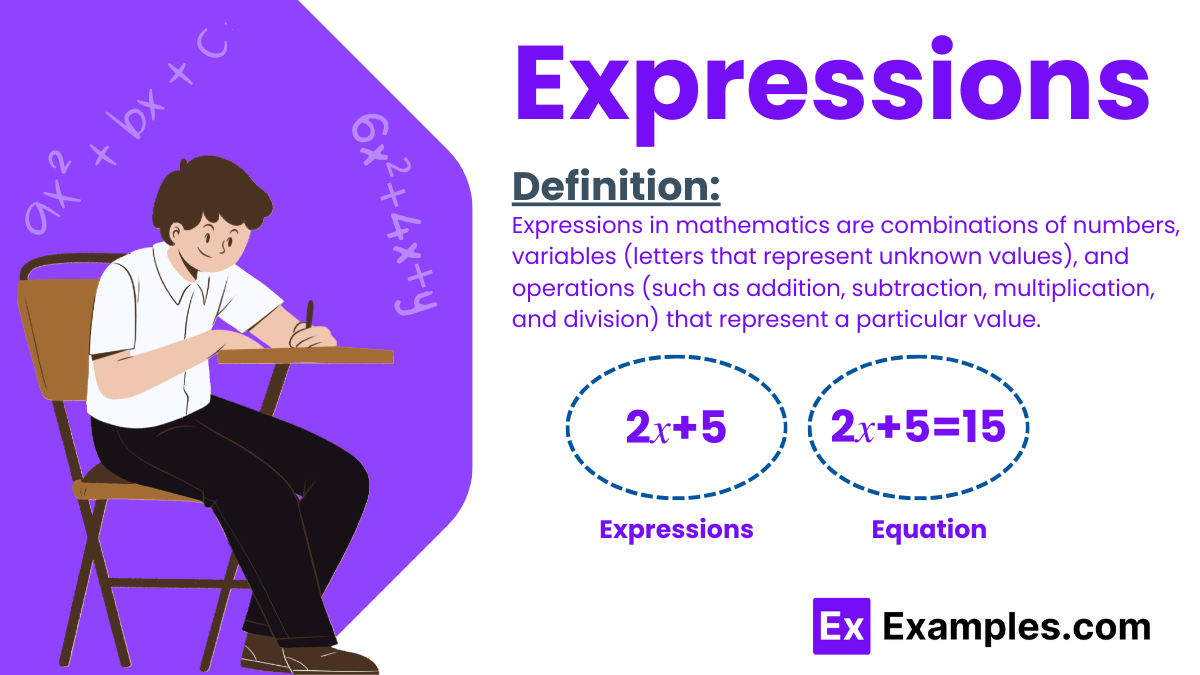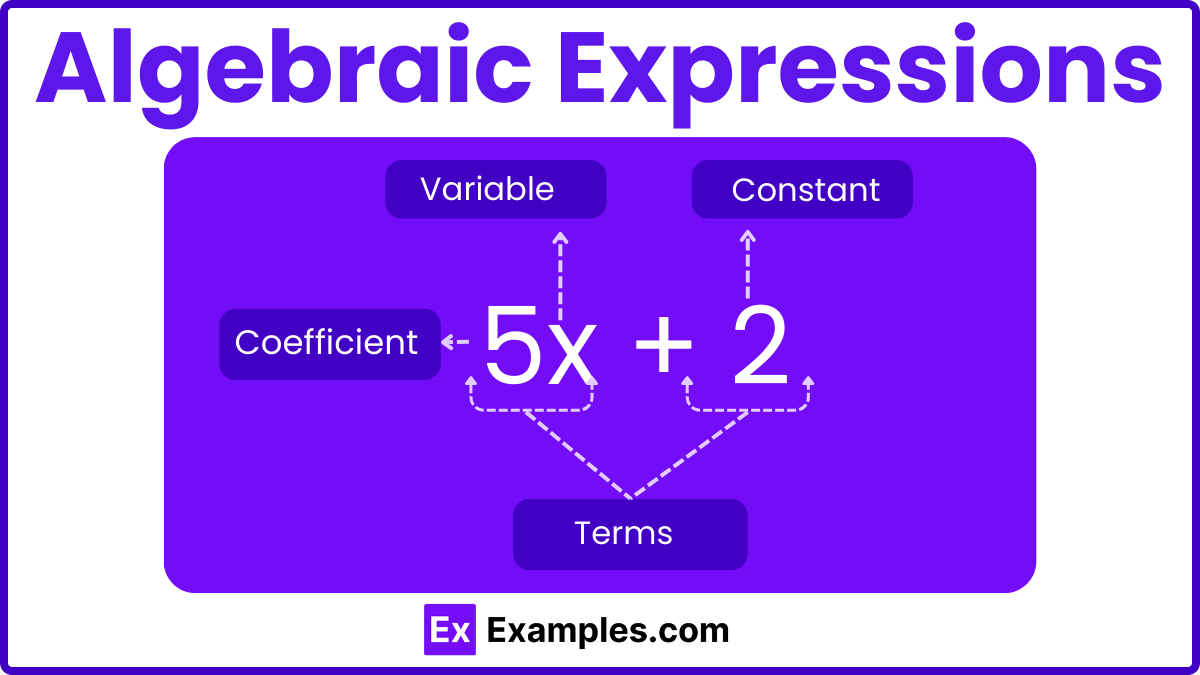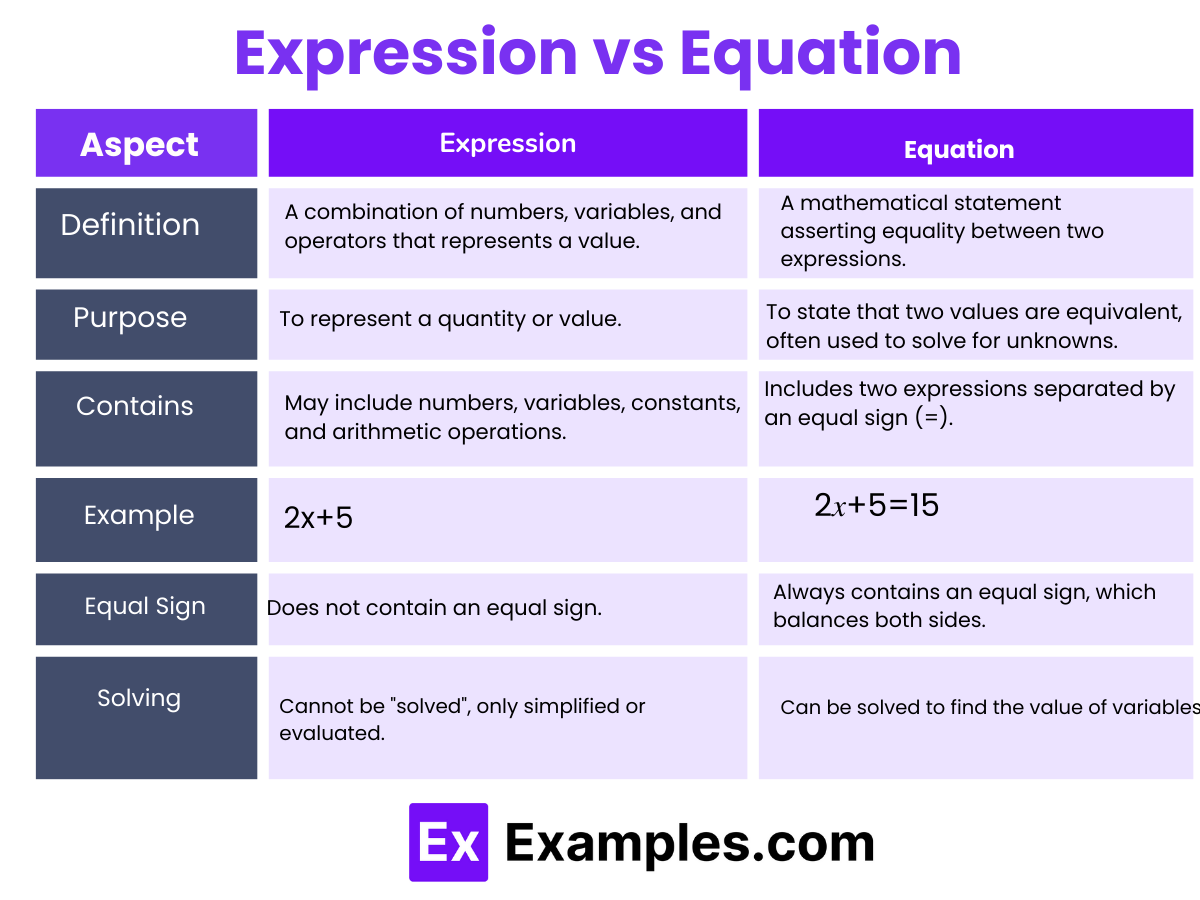Simplify the expression: \(3(x + 2) + 4x\)
\(3x + 6 + 4x\)
\(3x + 8\)
\(7x + 6\)
\(12x + 2\)


Expressions in mathematics are combinations of numbers, variables (letters that represent unknown values), and operations (such as addition, subtraction, multiplication, and division) that represent a particular value. Unlike equations, expressions do not have an equal sign. They are used to convey a mathematical idea or quantity without explicitly stating an equality.
Mathematical expressions are fundamental constructs in algebra that consist of terms joined by mathematical operations like addition, subtraction, multiplication, and division. Here’s a breakdown of the critical elements that make up mathematical expressions:

Mathematical expressions can be broadly categorized into three types based on the terms they include. Each type plays a crucial role in various mathematical calculations and problem-solving scenarios. Below, we’ll delve into each category, explaining their distinct characteristics and functions.
| Type of Expression | Definition | Example |
|---|---|---|
| Arithmetic Expressions | Consist solely of numbers and operation symbols, without any variables. | 7+4×2 |
| Fractional Expressions | Include numerators and denominators that are algebraic expressions. | 2𝑥+3/𝑥−5 |
| Algebraic Expressions | Contain variables, constants, and arithmetic operations, and can vary in complexity. | 3𝑥²−2𝑥+5 |
Algebraic expressions, particularly focusing on polynomials, which are divided based on the number of terms they contain. This classification includes monomials, binomials, trinomials, and general polynomials, providing clear definitions and examples for each:
| Type of Algebraic Expression | Definition | Example |
|---|---|---|
| Monomial | An expression with only one term, consisting of a coefficient and a variable raised to a power. | 5𝑥3 |
| Binomial | An expression that consists of two terms, which are not like terms. | 3𝑥²−2𝑥 |
| Trinomial | An expression made up of three terms, which are not like terms. | 𝑥²−4𝑥+4 |
| Polynomial | A more general category that includes expressions with one or more terms (including monomial and above). | 4𝑥³−3𝑥²+2𝑥−1 |

| Aspect | Expression | Equation |
|---|---|---|
| Definition | A combination of numbers, variables, and operators that represents a value. | A mathematical statement asserting equality between two expressions. |
| Contains | May include numbers, variables, constants, and arithmetic operations. | Includes two expressions separated by an equal sign (=). |
| Purpose | To represent a quantity or value. | To state that two values are equivalent, often used to solve for unknowns. |
| Example | 2𝑥+5 | 2𝑥+5=15 |
| Equal Sign | Does not contain an equal sign. | Always contains an equal sign, which balances both sides. |
| Solving | Cannot be “solved”, only simplified or evaluated. | Can be solved to find the value of variables. |
Simplifying mathematical expressions is a fundamental skill in algebra that helps make complex problems more manageable and solutions clearer. Here are step-by-step guidelines and tips for effectively simplifying expressions:
Problem: Simplify the expression 4𝑥+3𝑥−2+6
Solution: Combine like terms.
So, 4𝑥+3𝑥−2+6 simplifies to 7𝑥+4
Problem: Identify the coefficients and the constant in the expression 5𝑦²−3𝑦+7
Solution:
Problem: Simplify the expression 3(2𝑥+4)) using the distributive property.
Solution: Apply the distributive property:
So, 3(2𝑥+4) simplifies to 6𝑥+12
Problem: Factor out the greatest common factor from the expression 18𝑥²+9𝑥
Solution: Identify the greatest common factor:
So, the greatest common factor is 9x, and 18𝑥²+9x factors to 9𝑥(2𝑥+1)
Expressions are combinations of variables and constants using mathematical operations. Formulae are specific types of expressions that algebraically represent relationships between different variables.
The four main types of expressions are arithmetic (involving only numbers and operations), algebraic (including variables and constants), polynomial (a type of algebraic expression with multiple terms), and rational (involving ratios of polynomials).
Writing math expressions involves using symbols and notation to represent numbers, operations, and relationships. Ensure clarity by correctly using parentheses to dictate the order of operations.
Teach mathematical expressions by starting with basic arithmetic expressions, introducing variables for unknowns, and progressing to more complex algebraic forms. Use examples and practical problems for better understanding.
Text prompt
Add Tone
10 Examples of Public speaking
20 Examples of Gas lighting
Simplify the expression: \(3(x + 2) + 4x\)
\(3x + 6 + 4x\)
\(3x + 8\)
\(7x + 6\)
\(12x + 2\)
Evaluate the expression when \(x = 3\): \(2x^2 - 5x + 1\)
\(10\)
\(8\)
\(7\)
\(11\)
Expand the expression: \((x + 3)(x - 2)\)
\(x^2 + x - 6\)
\(x^2 - 5\)
\(x^2 - x - 6\)
\(x^2 - 6\)
Simplify the expression: \(4a - 2(a - 5)\)
\(4a - 2a + 10\)
\(2a + 10\)
\(2a - 10\)
\(6a - 10\)
Factor the expression: \(x^2 - 9\)
\((x - 3)(x + 3)\)
\((x + 3)^2\)
\(x(x - 9)\)
\((x - 3)^2\)
Simplify the expression: \(\frac{6x + 12}{3}\)
\(2x + 4\)
\(3x + 4\)
\(2x + 6\)
\(x + 4\)
Simplify the expression: \(5x - 3(2x - 4)\)
\(5x - 6x - 12\)
\(-x + 12\)
\(5x - 6x + 12\)
\(-x - 12\)
Expand the expression: \((2x + 1)(x - 3)\)
\(2x^2 - 5x - 3\)
\(2x^2 + x - 3\)
\(2x^2 - 6x + x - 3\)
\(2x^2 - 5x + 3\)
Evaluate the expression when \(y = 2\): \(y^2 - 4y + 5\)
\(1\)
\(-1\)
\(5\)
\(9\)
Factor the expression: \(2x^2 - 8x\)
\(2x(x - 4)\)
\(2(x - 4)\)
\(x(x - 8)\)
\(2(x^2 - 4x)\)
Before you leave, take our quick quiz to enhance your learning!

